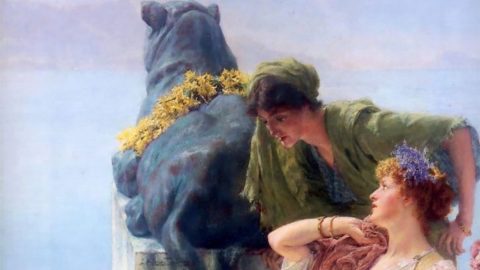In a Victorian London, among the bourgeoisie who loved the forms of landscape painting of English artists influenced by "Canalettian" Italian painting, the new rich preferred to escape from an overly regal conservatism, cultivating a passion for a distant art, full of freshness and subtle affectation. Authors such as Alma Tadema, Arthur Hughes or Edward Burne-Jones, founded what was called: Aesthetic Movement.
Sir Lawrence Alma-Tadema (1836-1912) Dutch painter naturalized British, was a Victorian and Edwardian artist, best known for his portraits of scenes of life in antiquity (particularly those set in the Pompeian era). His works are always characterized by romantic languor and refined indolence, as well as permeated by recurring floral motifs.
The painting is sublime Favorite poet (The Favorite Poet, 1888), two women, the first with her body abandoned and a gaze that goes beyond the observer, the second bent over to read the long rolled up parchment, notes and phrases of the favorite poet, love phrases written to sublimate, enchant and gather thoughts of seduction. Their clothes, soft and with soft colors and elegant transparencies lean on sinuous, young and perfect bodies. The frame is a precise architecture, a temple and its magnificence. A completely reinvented living environment.
This movement - which lasted a limited time - was only successful for a sort of "patronage", as wealthy people, nouveau riche from factories and ports, solid bourgeois of Liverpool, Manchester and Birmingham, in love with this "cult" painting financed the painters, allowing them to travel to discover places to inspire them.
But it is passion and love for beauty, as well as refined painting that enhances the work of Alma-Tadema. And who better than this artist manages to unite these two passions in such a valuable union?
A striking example of this is found in the painting: A Favorite Custom, 1909. Lhe depiction of life in a tepidarium, women and muses intent on welcoming guests. Moments of complete idleness, delicate and suspended in an atmosphere of lightness, no voice, bare feet dance on the marble accompanied by the rustle of the robes of perfumed towels enveloping the semi-naked and damp bodies. The allegory of a mask that "spits thermal water" is the accomplice of the games of the young vestals immersed in the tub, all timeless. Because this art sublimates time and makes it magnificently slow: "Utility of the useless".

Alma-Tadema's taste for reinterpreting Roman architecture fascinated many later authors, including Pre-Raphaelites and Victorian painters. Alma-Tadema's influence has continued to the present day, also captivating numerous Hollywood directors. Among them, David Wark Griffith (Intolerance, 1916) and Cecil B. De Mille (The Ten Commandments, 1956), as well as Ridley Scott (Gladiator, 2000).





